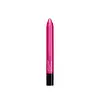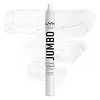What's inside
What's inside
 Key Ingredients
Key Ingredients

 Benefits
Benefits

No benefits
 Concerns
Concerns

 Ingredients Side-by-side
Ingredients Side-by-side

Isononyl Isononanoate
EmollientTriheptanoin
Skin ConditioningC12-15 Alkyl Benzoate
AntimicrobialOzokerite
Emulsion StabilisingHydrogenated Coco-Glycerides
EmollientSynthetic Wax
AbrasiveHydrogenated Microcrystalline Wax
Emulsion StabilisingHydrogenated Coconut Oil
EmollientHydrogenated Styrene/Methylstyrene/Indene Copolymer
Silica
AbrasiveMethyl Methacrylate Crosspolymer
Calcium Aluminum Borosilicate
Methoxy PEG-17/Methoxy PEG-11/Hdi Isocyanurate Trimer Crosspolymer
Polyethylene
AbrasivePhytosteryl Oleate
Skin ConditioningAstrocaryum Murumuru Seed Butter
EmollientPhytosteryl Macadamiate
Skin ConditioningHelianthus Annuus Seed Oil
EmollientSorbic Acid
PreservativePhenoxyethanol
PreservativePassiflora Edulis Seed Oil
EmollientSchinziophyton Rautanenii Kernel Oil
EmollientMacadamia Integrifolia Seed Oil
Skin ConditioningArgania Spinosa Kernel Oil
EmollientQuaternium-90 Bentonite
Tocopherol
AntioxidantTriethoxycaprylylsilane
Cocos Nucifera Oil
MaskingTin Oxide
AbrasivePentaerythrityl Tetra-Di-T-Butyl Hydroxyhydrocinnamate
AntioxidantGlycine Soja Oil
EmollientTitanium Dioxide
Cosmetic ColorantMica
Cosmetic ColorantCI 75470
Cosmetic ColorantIsononyl Isononanoate, Triheptanoin, C12-15 Alkyl Benzoate, Ozokerite, Hydrogenated Coco-Glycerides, Synthetic Wax, Hydrogenated Microcrystalline Wax, Hydrogenated Coconut Oil, Hydrogenated Styrene/Methylstyrene/Indene Copolymer, Silica, Methyl Methacrylate Crosspolymer, Calcium Aluminum Borosilicate, Methoxy PEG-17/Methoxy PEG-11/Hdi Isocyanurate Trimer Crosspolymer, Polyethylene, Phytosteryl Oleate, Astrocaryum Murumuru Seed Butter, Phytosteryl Macadamiate, Helianthus Annuus Seed Oil, Sorbic Acid, Phenoxyethanol, Passiflora Edulis Seed Oil, Schinziophyton Rautanenii Kernel Oil, Macadamia Integrifolia Seed Oil, Argania Spinosa Kernel Oil, Quaternium-90 Bentonite, Tocopherol, Triethoxycaprylylsilane, Cocos Nucifera Oil, Tin Oxide, Pentaerythrityl Tetra-Di-T-Butyl Hydroxyhydrocinnamate, Glycine Soja Oil, Titanium Dioxide, Mica, CI 75470
Isononyl Isononanoate
EmollientOctyldodecanol
EmollientEthylhexyl Palmitate
EmollientIsostearyl Isostearate
EmollientEuphorbia Cerifera Wax
Ceresin
Emulsion StabilisingMicrocrystalline Wax
Emulsion StabilisingCopernicia Cerifera Wax
Polyethylene
AbrasiveBeeswax
Emulsion StabilisingTocopheryl Acetate
AntioxidantBHA
AntioxidantButylparaben
MaskingIsobutylparaben
AntimicrobialIsopropylparaben
PreservativeMica
Cosmetic ColorantCI 77891
Cosmetic ColorantIron Oxides
CI 75470
Cosmetic ColorantCI 77288
Cosmetic ColorantCI 77007
Cosmetic ColorantCI 77510
Cosmetic ColorantCI 42090
Cosmetic ColorantCI 19140
Cosmetic ColorantIsononyl Isononanoate, Octyldodecanol, Ethylhexyl Palmitate, Isostearyl Isostearate, Euphorbia Cerifera Wax, Ceresin, Microcrystalline Wax, Copernicia Cerifera Wax, Polyethylene, Beeswax, Tocopheryl Acetate, BHA, Butylparaben, Isobutylparaben, Isopropylparaben, Mica, CI 77891, Iron Oxides, CI 75470, CI 77288, CI 77007, CI 77510, CI 42090, CI 19140
 Reviews
Reviews

Alternatives
Ingredients Explained
These ingredients are found in both products.
Ingredients higher up in an ingredient list are typically present in a larger amount.
Ci 75470 is a bright-red pigment. It is AKA carmine.
Carmine is derived from insects such as the cochineal beetle. This ingredient has been used as a natural dye for over 2000 years.
Isononyl Isononanoate is a synthetic skin-conditioner and texture enhancer. It is created from nonanoic acid, a fatty acid found in cocoa and lavender oil.
As an emollient, Isononyl Isononanoate helps keep your skin soft and smooth. This is because emollients create a barrier on the skin to trap moisture in.
Isononyl Isononanoate helps give products a velvet feel and improves spreadability.
Learn more about Isononyl IsononanoateMica is a naturally occurring mineral used to add shimmer and color in cosmetics. It can also help improve the texture of a product or give it an opaque, white/silver color.
Serecite is the name for very fine but ragged grains of mica.
This ingredient is often coated with metal oxides like titanium dioxide. Trace amounts of heavy metals may be found in mica, but these metals are not harmful in our personal products.
Mica has been used since prehistoric times throughout the world. Ancient Egyptian, Indian, Greek, Roman, Aztec, and Chinese civilizations have used mica.
Learn more about MicaPolyethylene is a synthetic ingredient that helps the skin retain moisture. It is a polymer.
It is also typically used within product formulations to help bind solid ingredients together and thicken oil-based ingredients. When added to balms and emulsions, it helps increase the melting point temperature.